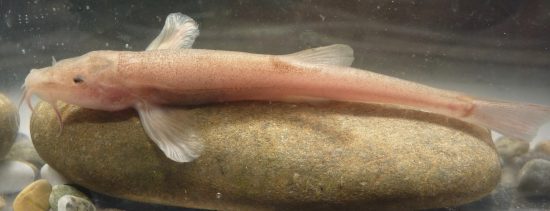







Fish is also world's most northerly cave fish
Few species are as well hidden as those that live underground. In
Europe, there are many animals in the underwater caves and in the
groundwater that we do not know about. To date, such animals did not
include any fishes in Europe, even though cave fishes have been found
in many other continents.
Now, a team of cave divers and researchers from the Universities of
Konstanz and Oldenburg/Max-Planck Institute for Evolutionary Biology
Plön and the Leibniz-Institute of Freshwater Ecology and Inland
Fisheries Berlin have discovered the first cave fish in Europe.
The newly discovered fish is also the world's most northerly cave fish.
It was found not in the Balkans where most European cave-dwelling
species live, but in one of the least expected places – Germany.
“We
assume that there is a large population of cave fishes in the 250
square kilometre underground karst water system where percolating water
from the Danube flows to the Aach spring north of Lake Constance,” said Dr Jasminca Behrmann-Godel, from the University of Konstanz.
Finding cave fish so far north was unexpected. It was assumed that they
are only found in places were ice-age glaciers had not buried
everything in the vicinity.
The research suggests that the cave fish
had vanished into the dark and thus became a troglodyte (cave dweller).
Since there are no predators in their environment, life for the loach
is very safe. It is likely that they feed on small cave crustaceans and
cave snails in the underwater passages.
“It was only when the glaciers
retreated that the system first became a suitable habitat for fishes.
They must have moved there at some point following the end of the Würm
glacial period, a maximum of 20,000 years ago and seemingly from the
Danube. Our genetic analyses are very clear on this,” said Professor Arne Nolte from the University of Oldenburg/Max-Planck Institute for Evolutionary Biology Plön.
The dives were difficult; it took an hour to reach the location where the fishes were found
Dr. Jörg Freyhof, from the Leibniz Institute for Freshwater Ecology and Inland Fisheries (IGB), Berlin, explained, “In
this short period of time, from an evolutionary perspective, the fishes
have developed into real cave fish. Their eyes are much smaller than in
surface fish, almost as if they were curved inwards and their colouring
has almost disappeared. The fish have elongated projections on their
heads, so-called barbels, and their nostrils are larger than those of
their cousins who live closer to the surface.”
The dives were difficult, as the cave divers had to swim against the
current from the entrance into the underwater system in the Aach
spring. They took an hour to reach the location where the fishes were
found, about 600 metres away from Aach spring.
“Diving
in this area is for real professionals. For instance, on the way, there
is a 'siphon shaft' that descends vertically for 40 metres. The divers
use special air mixtures here to shorten the decompression time on the
return journey. Poor visibility due to stirred-up mud from the current
also makes things a lot more tricky,” said Joachim Kreiselmaier.
He had discovered the first cave loaches during one of the three-hour dives in August 2015.
Think of the underwater system of the Danube drainage area between
Immendingen and Möhringen up to the Aach spring as a flooded tunnel
system. Its linear distance is just 12.5 kilometres, before the water
drains into a sloping underwater area.
“We don't know exactly what the system looks like but there must be farther underground rivers and lakes,” said Roland Berka, who has spent many decades studying the geological formation of the region.
The recent evolutionary history of these fishes promises to be an
interesting topic for future research. Indeed, this spectacular
discovery shows that even in Germany, one of the world's most widely
researched countries, new things can still be found.
Video-Link
 Herbert
Herbert 5th April 2017
5th April 2017 Aachquelle, Aach, Deutschland
Aachquelle, Aach, Deutschland 